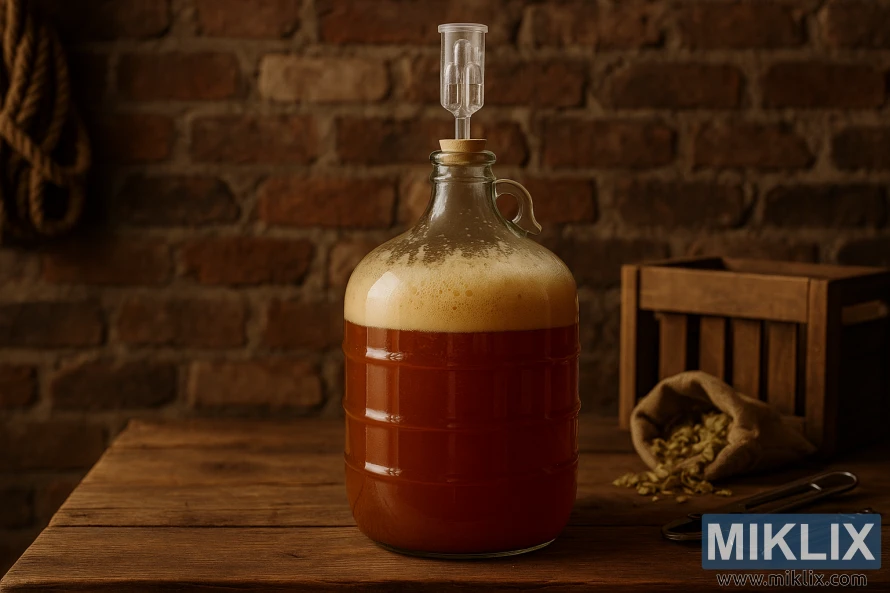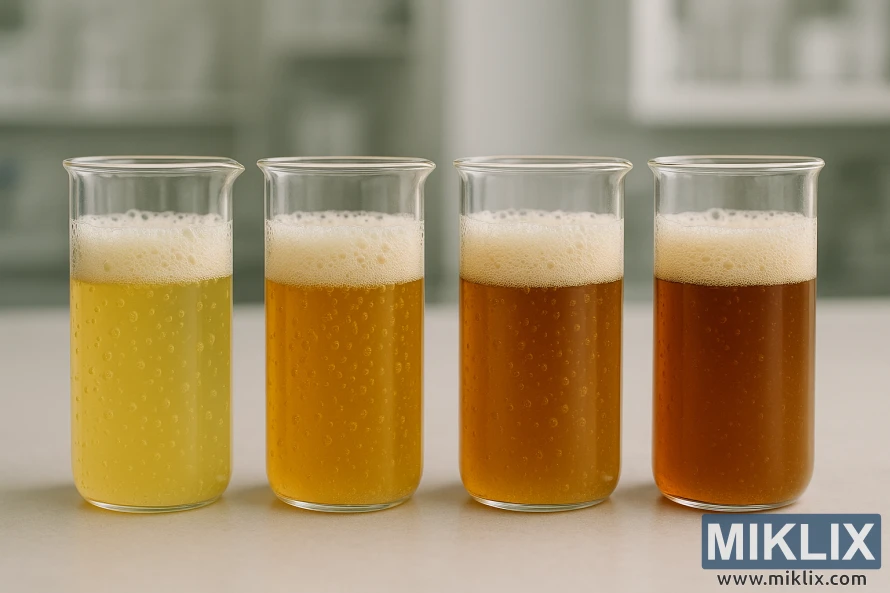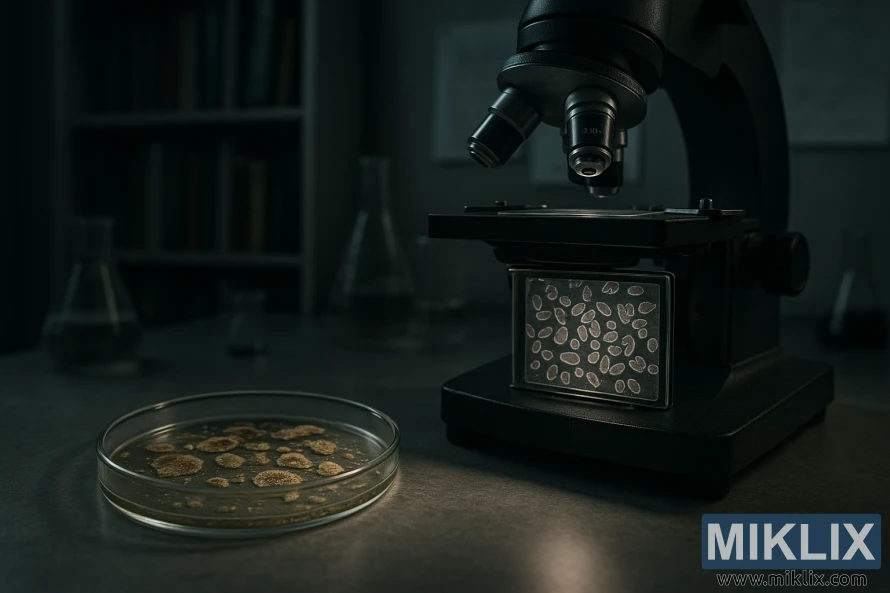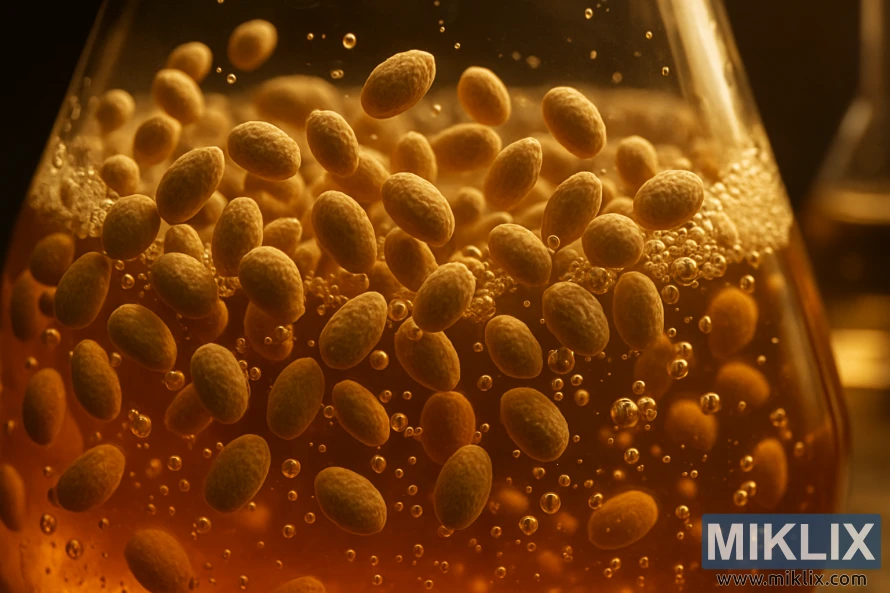Fermenting Beer with CellarScience English Yeast
Published: August 4, 2025 at 4:54:04 PM UTC
Last updated: November 27, 2025 at 11:31:37 PM UTC
Creating the perfect beer hinges on the choice of yeast. CellarScience English Yeast stands out for its clean flavor and neutral aroma. It's celebrated for its quick fermentation, making it perfect for English ales. This yeast's characteristics lead to efficient fermentation, resulting in a dry finish. It's ideal for both traditional English ales and innovative recipes. CellarScience English Yeast is a go-to for brewers seeking versatility.

Key Takeaways
- Rapid fermentation for efficient brewing
- Clean flavor and neutral aroma profile
- Ideal for producing high-quality English ales
- Dry finish suitable for various beer styles
- Versatile yeast for traditional and experimental brews
Understanding CellarScience English Yeast
For brewers aiming to improve their craft beer, grasping CellarScience English Yeast is essential. This yeast strain simplifies brewing, benefiting both homebrewers and professionals. It offers a straightforward and effective solution.
CellarScience English Yeast stands out for its ability to be sprinkled on wort without oxygenation at the start. This feature appeals to those seeking to streamline their brewing.
- Simplified brewing process
- No need for oxygenation during initial fermentation
- Consistent fermentation results
- Suitable for a variety of beer styles
By understanding CellarScience English Yeast's characteristics and benefits, brewers can make better choices. This can lead to improved quality and consistency in their craft beer.
Technical Specifications and Strain Characteristics
The technical aspects of CellarScience English Yeast, such as its fermentation temperature and alcohol tolerance, are key to the quality of the beer. These factors significantly influence the final product's characteristics.
CellarScience English Yeast ferments best between 61-70°F (16-21°C). This range makes it versatile for different brewing environments. Its high flocculation rate also ensures the yeast settles well, leading to clearer beer.
The yeast's alcohol tolerance is another critical aspect, with a maximum tolerance of 12% ABV. This makes it perfect for brewing stronger beers.
- Optimum fermentation temperature: 61-70°F (16-21°C)
- Flocculation rate: Very high
- Alcohol tolerance: 12% ABV
For brewers, understanding these technical specifications is vital. It helps optimize fermentation processes. This leads to producing high-quality beers that meet their specific requirements.
Optimal Fermentation Temperature Range
Fermentation temperature is key to CellarScience English Yeast's success. Keeping the temperature in the optimal range is vital. It ensures the yeast performs well, leading to high-quality beer.
The ideal fermentation temperature for CellarScience English Yeast is 61-70°F (16-21°C). This range allows the yeast to ferment efficiently. It produces the right flavors and aromas. Going outside this range can harm the beer's quality.
- Monitor temperature closely to maintain consistency within the optimal range.
- Use temperature control systems if necessary, to handle temperature fluctuations.
- Avoid extreme temperatures, as they can shock the yeast, leading to poor fermentation performance.
By controlling the fermentation temperature and keeping it within the recommended range, brewers can optimize yeast performance. This results in a higher quality final product. This attention to detail is essential for producing beers that meet quality standards.
Flavor Profile and Aroma Characteristics
Beers made with CellarScience English Yeast have a clean taste and smell, making them a favorite among brewers. This yeast provides a neutral base. It lets the hops and malts take center stage.
The taste is a mix of malt and hop flavors, with a hint of fruitiness. This adds depth to the beer. The aroma is also noteworthy, with a fine balance of esters and hop compounds.
- A clean and neutral flavor profile
- Subtle fruit notes that add complexity
- A balanced malt and hop character
CellarScience English Yeast is perfect for brewers aiming for top-notch beers. It ensures a consistent taste and smell. Its flexibility makes it great for various beer styles, from classic English ales to modern craft brews.
Alcohol Tolerance and Attenuation Rates
For brewers aiming to create high-quality beer, grasping the alcohol tolerance and attenuation rates of CellarScience English Yeast is essential. These factors significantly influence the yeast's performance and the beer's quality.
CellarScience English Yeast can handle up to 12% ABV, making it versatile for various beer styles, from ales to stronger brews. Its attenuation rate spans from 75-83%, showing its efficiency in fermenting sugars.
The attenuation rate is vital in brewing. It impacts the beer's final gravity, flavor, and overall character. A higher rate leads to a drier beer, while a lower rate results in a sweeter taste due to more residual sugars.
- Key characteristics of CellarScience English Yeast include:
- Alcohol tolerance of 12% ABV
- Attenuation rate of 75-83%
- Suitability for a wide range of beer styles
Understanding these traits helps brewers predict the yeast's performance. This knowledge aids in making informed decisions for different brewing scenarios.
Compatible Beer Styles and Applications
CellarScience English Yeast is perfect for brewing a wide range of ales. It's great for everything from malty Ambers to hoppy IPAs. This makes it a go-to for brewers aiming to craft many different ale styles.
It's ideal for all ales, from those with a strong malt flavor to high-gravity IPAs and hoppy Pales. Its versatility lets brewers try out various recipes. They can do this while keeping fermentation quality consistent.
The yeast is a top pick for traditional English ales, where balance is key. Yet, it's also great for modern, hop-heavy beers. It can handle high hop loads without losing fermentation efficiency.
Some of the key beer styles that CellarScience English Yeast is compatible with include:
- Amber Ales
- Porters
- IPAs
- Pale Ales
- Bitters
Choosing CellarScience English Yeast lets brewers create a variety of beers. They can cater to different tastes and preferences.

Handling and Storage Requirements
Understanding the handling and storage needs of CellarScience English Yeast is key to achieving the best results. Proper management of the yeast is vital for its viability and performance in brewing. This ensures the quality of the final product.
CellarScience offers 12g of yeast per sachet, which is significantly more than other dry yeast brands. This generous amount ensures brewers have enough yeast for their needs. Yet, it also highlights the importance of proper storage to keep the yeast effective.
When working with CellarScience English Yeast, following certain guidelines is essential. Store the yeast in a cool, dry place, away from sunlight and moisture. The ideal storage temperature is below 40°F (4°C), but it should not be frozen.
- Keep the yeast sachets sealed until use to prevent moisture absorption.
- Once opened, rehydrate the yeast properly before pitching into the wort.
- Minimize exposure to air to prevent oxidation and maintain yeast viability.
By following these handling and storage guidelines, brewers can ensure their CellarScience English Yeast remains viable. This results in high-quality brews, meeting the highest standards.
Performance Comparison with Similar Strains
In the English ale yeast market, several strains emerge as leaders. These include CellarScience English Yeast, WY1098, and WLP007. Each strain boasts unique strengths and weaknesses.
When comparing CellarScience English Yeast to strains like WLP007, WY1098, and S-04, several factors are considered. These include fermentation characteristics, flavor and aroma contributions, and overall brewing performance.
CellarScience English Yeast is celebrated for its balanced fermentation profile. It produces beers with complex flavors. In contrast, WLP007 and WY1098 are also known for their ability to enhance beer complexity. They may, though, have slightly different optimal fermentation temperatures.
- CellarScience English Yeast: Offers a balanced flavor profile and is suitable for a wide range of English ale styles.
- WLP007: Known for its dry, crisp finish and is often used in brewing traditional English ales.
- WY1098: Provides a fruitier ester profile compared to some other strains, making it a good choice for brewers looking to add depth to their beers.
- S-04: A popular choice among brewers due to its high flocculation rate and ability to produce clean, crisp flavors.
The choice between these yeast strains depends on the brewer's specific needs and the style of beer being produced. By understanding each strain's characteristics, brewers can make informed decisions. This helps them achieve their desired beer profile.
In terms of alcohol tolerance and attenuation rates, CellarScience English Yeast and its counterparts have different strengths. For instance, S-04 is known for its high attenuation, resulting in drier beers. On the other hand, WY1098 may produce beers with a slightly sweeter finish due to its lower attenuation.

Brewing Process and Best Practices
To get the best results with CellarScience English Yeast, brewers need to grasp the optimal brewing process and best practices. This yeast is made to be sprinkled directly onto the wort's surface. This eliminates the need for pre-oxygenation before pitching.
When brewing with CellarScience English Yeast, several key factors contribute to a successful fermentation. These include:
- Pitching rates: Ensure the correct amount of yeast is used for the volume of wort being fermented.
- Fermentation conditions: Maintain optimal temperature ranges as specified for the yeast strain.
- Monitoring fermentation progress: Regularly check on the fermentation to ensure it is proceeding as expected.
By following these guidelines and understanding the characteristics of CellarScience English Yeast, brewers can optimize their brewing process. This includes being mindful of the yeast's alcohol tolerance and attenuation rates to produce the desired beer style.
Best practices also involve proper handling and storage of the yeast to maintain its viability. By adhering to these principles, brewers can consistently produce high-quality beers that showcase the full range of CellarScience English Yeast's capabilities.
Common Challenges and Troubleshooting
Brewers, even with top-notch yeast like CellarScience English Yeast, often face common hurdles that can impact fermentation. It's vital to grasp these issues and learn how to fix them for a successful brew.
One frequent problem is yeast activity and fermentation performance. Issues like temperature swings, not enough yeast, or poor wort quality can hinder fermentation.
To tackle these challenges, brewers must control their fermentation environment, mainly the temperature. CellarScience English Yeast thrives within a specific temperature range. Staying outside this range can harm yeast performance.
When troubleshooting yeast problems, it's important to check the yeast pitching rate and confirm the yeast's health. Underpitching can stress the yeast, causing off-flavors or incomplete fermentation.
- Verify the yeast strain and its characteristics to ensure it matches the brewing plan.
- Check the fermentation temperature and adjust if necessary to fall within the optimal range for CellarScience English Yeast.
- Pitch the correct amount of yeast according to the manufacturer's guidelines or brewing standards.
Being proactive and addressing brewing challenges early can prevent many issues. Regular monitoring and understanding the yeast's traits are essential for effective troubleshooting.

Cost-Benefit Analysis and Value Proposition
The cost-benefit analysis of using CellarScience English Yeast shows it's a smart choice for brewers. It combines high-quality fermentation with competitive pricing. This makes it appealing to breweries of all sizes.
CellarScience English Yeast is known for its consistent, high-quality results. This consistency can save costs by reducing re-brews and improving brewing efficiency.
In terms of cost, CellarScience English Yeast is priced well in the market. Brewers must consider the cost against the yeast's performance and benefits. Its high alcohol tolerance and attenuation rates add to its value. These features allow brewers to confidently produce a variety of beer styles.
The choice to use CellarScience English Yeast hinges on its value proposition. It offers a balance of quality, performance, and cost-effectiveness. This makes it a compelling option for brewers looking to optimize their processes.
User Reviews and Community Feedback
User reviews show a high satisfaction rate with CellarScience English Yeast. Brewers commend its consistent and high-quality fermentation results.
The brewing community has shared many positive experiences with this yeast strain. They've noted its ease of use and the excellent flavor profiles it produces. For example, CellarScience English Yeast adds a smooth, rounded character to beers. It also balances ester production, adding complexity.
Common praises include its reliability in various fermentation conditions. It's also praised for its compatibility with a range of beer styles. The community feedback highlights its favor for traditional English ales, where its subtle ester production is valued.
Key benefits highlighted by users include:
- Consistent fermentation performance
- Excellent flavor profile and aroma contribution
- Ease of handling and pitching
- Compatibility with a variety of brewing techniques and beer styles
Overall, brewers agree that CellarScience English Yeast is a reliable and high-performing yeast strain. It helps achieve professional-quality brews. Its popularity in the brewing community reflects its effectiveness and value for brewers of all levels.
Conclusion
CellarScience English Yeast stands out as a versatile and dependable brewing yeast. It's perfect for a wide range of beer styles. Its unique traits and benefits make it a top pick for brewers aiming to craft high-quality beers.
Key points about the yeast include its optimal fermentation temperature, flavor profile, and alcohol tolerance. These features, along with its compatibility with various beer styles, make CellarScience English Yeast a valuable asset in brewing.
Using CellarScience English Yeast can greatly improve the brewing experience. It allows brewers to consistently achieve the desired results. As a brewing yeast, it offers a great solution for creating complex and nuanced beers.
In summary, CellarScience English Yeast is a high-quality yeast strain ideal for brewers aiming to produce a variety of beer styles. Its characteristics and benefits make it a worthwhile choice for any brewer looking to enhance their craft.

Further Reading
If you enjoyed this post, you may also like these suggestions:
- Fermenting Beer with Mangrove Jack's M41 Belgian Ale Yeast
- Fermenting Beer with White Labs WLP590 French Saison Ale Yeast
- Fermenting Beer with Lallemand LalBrew Köln Yeast
